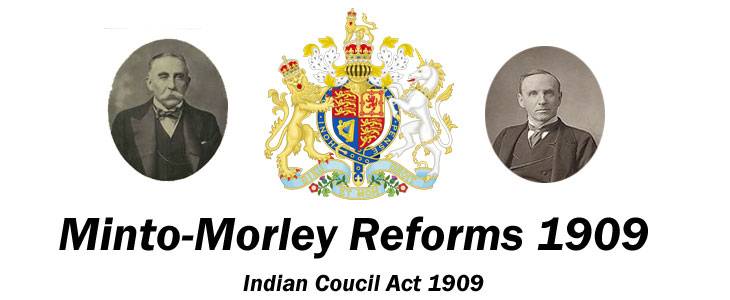Table of Contents
INDIAN COUNCILS ACT 1909 – MORLEY-MINTO REFORMS
INTRODUCTION
The Indian Councils Act 1909 was also known as the Morley-Minto reforms. The Act was named after the viceroy Lord Minto and the secretary of state Lord John Morley. This act intended on placating the moderates. According to this act, the central and provincial legislative council membership was enlarged. But the number of elected members were less than half of the total membership. The members were not elected by the people but by landlords, traders, industrialists and local bodies. The Britishers also brought in communal electorates which intended on creating disparities between Hindus and Muslims.
They tried to weaken the nationalist movement by constantly spreading the idea of communalism. This had serious consequences which impacted the nation’s unity and the freedom struggle. The Congress was divided into two parts, the moderates and extremists. The Moderates in 1909 accepted the reforms but the extremists refused these reforms. The All India Muslim League accepted this proposal as it also spoke about giving Muslims a separate electorate.
FEATURES OF INDIAN COUNCILS ACT 1909
The features of the Indian Councils Act, 1909 are as follows-
- It increased the size of the central and provincial legislative council to a considerable amount.
- It provided for the very first time, the association of Indians with the executives’ councils of Viceroys and governors. Satyendra Prasad Sinha became the first Indian to join the Viceroy’s Executive Council as a law member.
- It also provided a separate representation for Chamber of Commerce, universities etc.
- It also introduced a separate electorate system for only Muslims where it was said that Muslim members will be elected only by Muslim voters. Thus, the act legalized communalism and Lord Minto came to be known as ‘Father of Communal Electorates’.
- They could also ask supplementary questions, discuss matters of public interest and also pass budgets.
- The legislative councils at the center and provinces had been divided into four categories of members- Ex- officio members which consisted of the Governor general and executive council members, official members nominated by the governor-general, non official members nominated by the governor general and the other elected members from different regions of the country.
ALSO READ
- Indian Councils Act, 1861 – Salient Features
- Government of India act, 1919 (Montague-Chelmsford Reforms)
- Government of India act, 1935 – salient features
MERITS OF INDIAN COUNCILS ACT 1909
The merits of the Indian Councils Act, 1909 were-
- This electorate system laid down a basic structure of parliamentary system which was contrary to what Lord Minto proposed.
- It also allowed the Indians to be a part of the legislative council for the first time.
DEMERITS OF INDIAN COUNCILS ACT 1909
- The Congress had demanded for self- government but Lord Minto refused it by saying that self-government does not suit India and he was against the parliamentary form of government.
- The communal system created rifts in the society and caused disharmony.
- Indirect elections and narrow franchises allowed the entry of people in a undemocratic manner.
CONCLUSION
The Morley – Minto reforms did not bring any significant change in the power of the councils. They did not advance towards the establishment of a representative government. The autocratic form of government which came up after the revolt of 1857 remained unchanged.
Like stated above, the only change was that Indians were given a chance to have a higher position. Satyendra Prasad Sinha who was earlier a law member in the executive council later was made the governor of a province. He was also presented at the Imperial Durbar in 1911, where King George and his queen were also present. Two very important announcements were made there, on was the annulment of the partition of Bengal which was in 1905 and secondly the shifting of the capital from Calcutta to Delhi. Inspite of all merits and demerits, the reforms definitely broadened the space for political development and opened the door for real politics.
Author: Vaishnavi Menon,
MIT WPU School of Law, 1st year

